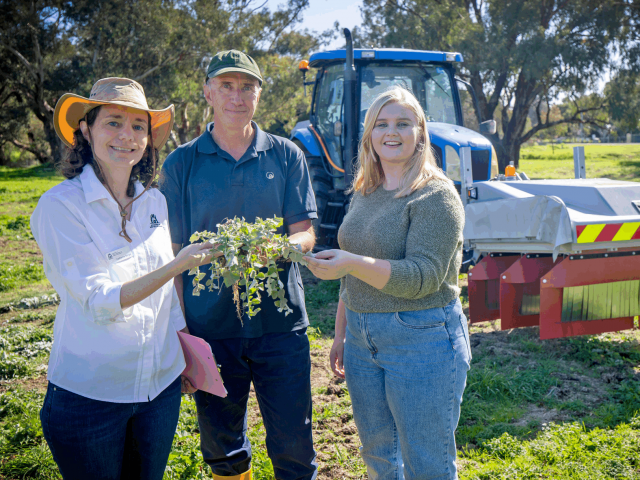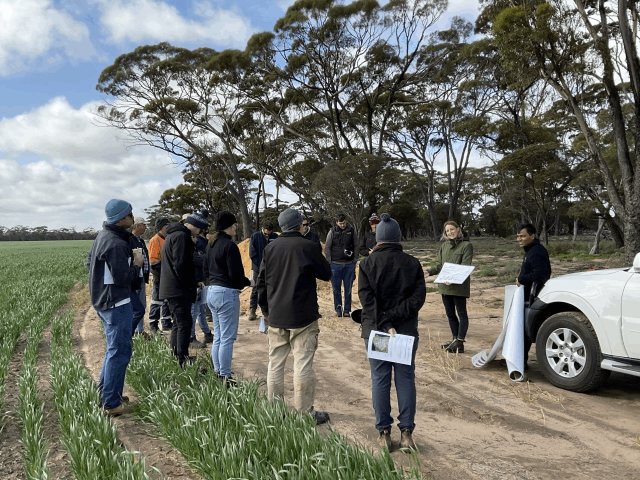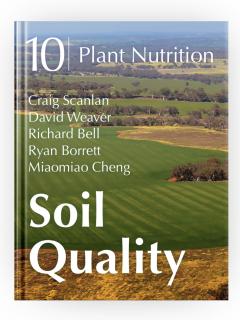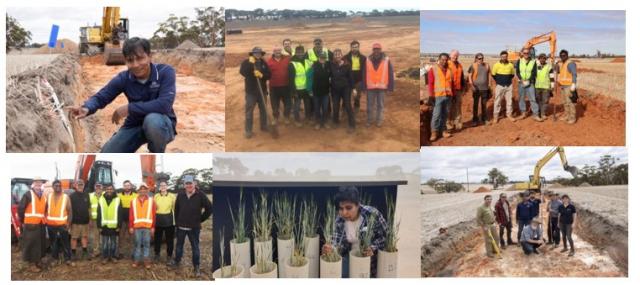Electric weed control project marks second year
Project name
What's the best fit for electric weed control?
GRDC Code
DAW2303-002OPX
Innovative project progresses
Managing weeds is a significant challenge, both in Australia and worldwide.
To avoid soil erosion, growers are using fewer mechanical tools to control weeds and relying more on herbicides, leading to higher rates of herbicide resistance.
To tackle this problem, alternative forms of weed management need to be considered.
Department of Primary Industries and Regional Development (DPIRD) researchers are investigating the effectiveness of an electric weed control machine called the AGXTEND XPower, powered by the company Zasso.
This is occurring through a project that includes collaboration from AGXTEND (a brand of CNH Industrial), as well as support from the Grains Research and Development Corporation, Wine Australia, the Cotton Research and Development Corporation, AHA Viticulture and the Western Australian Local Government Association.
This is an Australian-first project investigating electric weed control which is now in its second year.
The machine uses mechanical power to produce a high voltage current, which is applied directly to plants through a series of electrodes mounted behind or in front of the tractor.
As the electricity passes through the plant, the cell walls are destroyed.
This process either kills the plant or suppresses the growth.
But there are lots of things that can affect the efficacy of electric weed control.
How strong the electricity is, what the weed looks like, and the environment it's in can all make a difference.
So, the project will also examine which weeds are easiest to control with electricity and the technology’s potential uses in Australian agriculture to generate cost savings and influence crop yields.
Comparing the findings
DPIRD research scientist Miranda Slaven said the results are promising thus far.
“Last year’s trials have shown that electric weed control is effective when used at the right application speeds and under the right environmental conditions.
In the 2022 trials, effective control was achieved for annual ryegrass, kikuyu, wild radish, capeweed, soursob, and medic at application speeds of 1-4 km/h.
However, it is noted that broad leaf weeds are easier to control than grass weeds due to differences in plant structure.
Therefore, application speeds (i.e. ‘dose’ of electricity) need to be adjusted accordingly, as would occur with herbicide application rates,” she said.
Trials conducted this year by DPIRD have shown further success including the analysis of the effectiveness of electric weed control on herbicide resistant weed populations with a trial on glyphosate resistant annual ryegrass.
Operating the electric weed control at a speed of 2 km per hour proved highly effective in reducing weed biomass by more than nine times compared to using glyphosate (RoundUp Ultra Max at 1.5 L per hectare).
This finding shows that growers facing herbicide-resistant weeds could use electric weed control as an alternative option to chemicals.
For instance, this technology can be employed along fences or roadsides, and for maintaining fire breaks.
Looking to other applications
DPIRD is also investigating the integration of precision agriculture applications with this technology in this year’s trials.
The AGXTEND machinery records both its power output and GPS location during operation.
The power output varies based on weed size and density, and this data can potentially be used to create a precision map of weed incidence.
DPIRD is connecting this information with weed biomass data and drone imagery to generate such maps.
Contact
Miranda Slaven
DPIRD Research Scientist
E: Miranda.Slaven@dpird.wa.gov.au
P: (08) 9690 2111
Research collaboration investigates status of soil acidity in the Avon River Basin
Project name
On-farm soil acidity and nutrient management
Funded by
Department of Water and Environmental Regulation
Impacts of soil acidity
Researchers from the Department of Primary Industries and Regional Development (DPIRD) with support from the Department of Water and Environmental Regulation (DWER) and Precision SoilTech, have finished a 3-year project investigating the state of soil acidity in the Avon River Basin.
In the wheatbelt, soil acidity is estimated to result in production losses of $498 million.
Soil acidity impacts nutrient use efficiency and agricultural productivity through two main avenues:
In the topsoil (0–10 cm) low soil pH reduces the availability of key nutrients and trace elements.
While in the subsurface soil (below 10 cm) low soil pH increases aluminium in solution, which is toxic to crop roots.
The toxic levels of aluminium reduce crop root growth, affecting the plant’s ability to access to moisture and nutrients.
To counter soil acidity, farmers often use agricultural lime to increase soil pH.
However, in WA it is estimated that only 60 per cent of the required lime to treat and prevent soil acidity is currently being applied.
This study builds upon previous research by DPIRD and Precision SoilTech, looking at a vast soil dataset for the WA grain-growing region.
Between 2005 and 2012, a substantial portion of the soil had suboptimal pH levels, leading to reduced productivity and economic losses.
Methodology and key findings
Between 2020-2023, DPIRD again contracted Precision SoilTech to collect and test soil samples for soil pH. Soil test results were provided back to the growers with recommendations as well as analysed by DPIRD.
Over half of the samples had pH levels above the target range in the topsoil, and a substantial proportion exceeded critical and target thresholds by over 20 per cent (See Table X), indicating improvement since 2005-2012.
Table X. Percent of soil samples above target soil pH levels in the 2005-2012 state-wide survey region compared to the 2020-2023 Avon River Basin survey region.
|
| 2005-2012 State-wide | 2020-2023 Avon River Basin |
| 0-10cm pH >5.5 | 30% | 57% |
| 10-20cm pH >4.8 | 50% | 72% |
| 20-30cm pH >4.8 | 50% | 78% |
These results highlight growers' efforts to combat acidity in the Avon River Basin.
While the overall findings show improvement, specific examples reveal challenges in addressing soil acidity at greater depths.
The project also resampled a strategic tillage by lime field trial implemented by AgVivo in 2017 at Goomalling.
This trial compared various tillage options on a deep yellow sand, impacted by compaction, water repellence, and subsurface acidity constraints.
In 2023, six years after implementation, researchers examined how different strategic tillage options, including the addition of lime, affected soil pH levels down the profile.
The results (Figure 2) indicated that a combination of ripping and spading with lime had the most profound impact, particularly at greater depths.
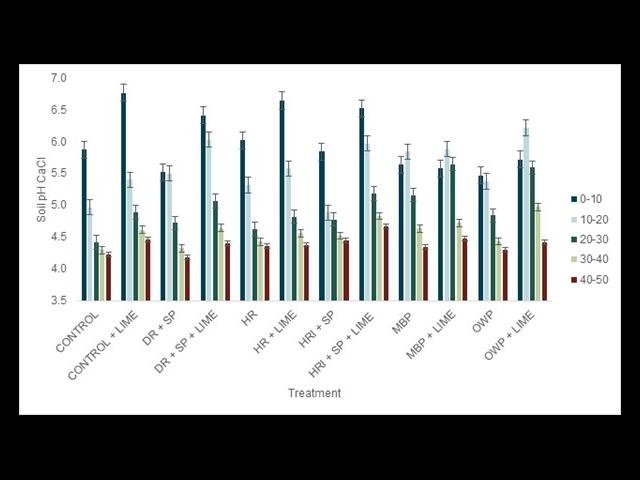
Other treatments, such as very deep ripping with inclusion plates, were effective at improving pH at deeper levels.
The trial confirmed that lime helps alleviate soil acidity, but it takes time to penetrate deeper layers.
Rapid soil pH changes at depth are achievable when lime is incorporated into the soil.
To manage soil acidity effectively, addressing depth-specific acidification is crucial.
In locations where soil acidity is present down to 50 cm a deeper ripping with inclusion plates and spading could produce the greatest subsurface soil pH change benefit.
While duplex soils with clay and higher pH at the 30-40 cm depth may only require inversion ploughing.
This trial highlights the importance of selecting the appropriate tillage option and lime rate to ameliorate acidity throughout the profile.
The results from both the trial and the main project illustrate growers' efforts to combat soil acidity.
While aggregate results indicate overall improvement compared to previous studies, specific examples highlight the challenges in addressing soil acidity at depth.
The insights gained from this project highlight the importance of soil sampling to depth to determine the necessary lime quantity and incorporation strategy to effectively ameliorate soil acidity.
Contact
Alice Butler
DPIRD Research Scientist
E: Alice.Butler@dpird.wa.gov.au
M: 0488 347 929
Gene-based molecular markers to improve genetic gains in challenging environments
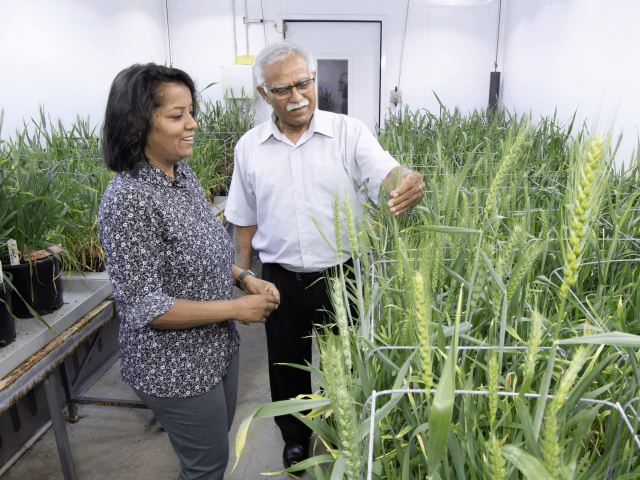
Project name
Exome-based new allele-specific PCR markers and transferability for sodicity tolerance in bread wheat (Triticum aestivum L.)
What is the project about?
Bread wheat is an allohexaploid with 3 sub genomes (A, B, and D) having 80 per cent repetitive DNA, making it challenging to study specific genes.
However, recent advances in genomics and sequencing technology are helping researchers to understand these genes better by targeting gene-rich regions of genome.
In a previous association analysis (read more about it here) a gene-based sequencing platform was used to identify new SNPs and haplotypes contributing to improved wheat productivity on sodic soils.
These SNPs are associated with genes and transcription factors, majorly involved in alleviating abiotic stress tolerance.
The location of these new SNPs was identified by aligning approximately 180 bp gene-based sequences from the sequencing platform onto the respective chromosome sequence of the International Wheat Reference Genome Sequence (also known as IWGSC1.0).
New molecular markers were designed around the identified SNP location.
The study provided 8 high throughput molecular markers associated with yield, plants (metres squared), heads (metres squared), and harvest index, including a pleiotropic (common) marker for yield, harvest index, and the grains per head.
Researchers confirmed the validity of these markers in a diverse germplasm and biparental population.
This integrated approach of discovering new SNPs, haplotypes and high-throughput molecular markers using gene-based sequencing offers translation solutions in crop improvement programs to improve complex traits and crop productivity.
Dr Roopali Bhoite said the application of functional gene-based molecular markers in breeding programs could rapidly improve genetic gains that support grower profitability and farm sustainability.
Contact
Dr Roopali Bhoite
DPIRD Research Scientist
E: Roopali.Bhoite@dpird.wa.gov.au
Unlocking WA soils' potential: Maintaining benefits of soil amelioration
Project name
Increased farming system profitability and longevity of benefits following soil amelioration
GRDC Code
DAW1901-006RTX
Soil amelioration combined with deep tillage
Western Australia’s arable lands faces a range of soil quality challenges, including subsoil acidity, subsoil compaction, and limitations in water and nutrient retention.
These issues can have a significant impact on crop productivity throughout the year.
Early research conducted in deep sandy soil areas of Western Australia demonstrated that wheat plants have the potential to access water as deep as 1.4 to 2.5 meters below the surface. Today crop plants are no longer reaching to 2.5m in sandy soil.
To address these challenges, soil amelioration techniques are employed, which typically involve the strategic application of soil amendments like lime, gypsum, organic matter, and clay-rich subsoil.
These techniques are often combined with deep tillage practices.
With the support of the Grains Research Development Corporation, researchers from the Department of Primary Industries and Regional Development have undertaken a research project that commenced in 2019 and is set to conclude in 2024.
The project aims to assist growers throughout the wheatbelt with ameliorated soils in adopting new farming systems techniques.
These techniques will help sustain the benefits of soil amelioration while reducing the risks associated with poor crop establishment, soil erosion, and the reemergence of soil constraints.
Amelioration Practices Survey and Case Studies
In 2019, researchers conducted interviews with 214 growers to investigate the adoption and implementation of strategic deep tillage practices for soil amelioration.
Feedback from growers and consultants in the Albany port zone indicated that there is uncertainty regarding the types and locations of soil amelioration needed in highly variable soil types.
Feedback from consultants suggest assessing crop production and targeting amelioration of highly responsive soils yields better results, rather than applying widescale amelioration across entire paddocks.
These observations are supported by the finding of the project case studies.
Rotation following amelioration
Crop choice plays a significant role in determining the longevity of the positive effects of soil amelioration on crop yields.
Seasonal variations did affect the outcomes of trials evaluating crop rotation post-amelioration.
For example, in the northern wheatbelt, wheat following a double break rotation (e.g., canola/lupin/wheat) outperformed continuous wheat cropping by 80 per cent.
Soil amelioration through spading or mouldboard ploughing did alter soil properties significantly, especially in terms of clay content, which affects the suitability of the soil for high-value pulse crops.
Preliminary trials have explored methods for assessing the impact of sand amelioration and soil amendment in controlled conditions.
Impact of timing of strategic deep tillage on crop productivity, profitability, and agronomic opportunities
The timing of soil amelioration is crucial for mitigating negative effects like erosion and maximising crop yields.
Early amelioration conducted from September to March increases the risk of soil erosion but enhances the yield potential for early-sown crops.
Late amelioration in June or July was found to reduce the erosion risk, which allows for effective weed management.
It also presents an opportunity for knockdown sprays for weed control, although it may come at the expense of yield potential due to late planting.
In 2021, the timing of amelioration had minimal impact on crop productivity, but late sowing dates, particularly for canola, resulted in reduced yields.
When late amelioration in June is combined with the use of well-adapted short and mid-short season wheat varieties, productivity can be increased while minimizing yield losses.
In 2022, wheat and canola sown in plots that had been ameliorated in 2021 showed higher yields due to retained nutrients and moisture.
Crop Establishment on Ameliorated Soils – herbicide interactions and coleoptile length
Around 25 per cent of farmers have experienced increased crop damage from herbicides applied after soil improvement.
The greatest risk is associated with herbicides that require separation from seeds or are influenced by changes in organic matter and clay content.
Understanding the levels of organic matter and clay in the soil post-amelioration can help farmers make safer weed management choices.
Herbicide effectiveness depends on clay content, organic matter, and soil moisture, which affect how strongly herbicides bind to soil particles.
Deep tillage that reduces the levels of soil surface organic matter also reduces the crop safety of certain herbicides.
Varieties of wheat with longer coleoptiles are recommended for deep sowing on freshly ameliorated soil.
These varieties, when combined with high germination rates, large kernels, and high protein content, can increase plant establishment without compromising yield.
Although deep sowing may lead to increased weed density, some varieties with strong early growth characteristics can alleviate this issue.
Amelioration and rotational impact on soil borne pathogens
Different mechanical amelioration techniques, such as deep ripping, soil mixing, and soil inversion, influence the distribution of pathogens, nematodes, and weed seeds in the soil.
These changes affect how these threats interact with crops, particularly in the early stages of growth, and impacts their long-term survival in the soil profile.
Soil properties are altered as a result of amelioration, which can enhance crop growth and modify interactions with these pests.
Soil inversion, especially through mouldboard ploughing, is particularly effective at burying root pathogens at depth.
Despite a higher number of pathogens in the 10-30 cm layers after four seasons of mouldboard ploughing, these plots exhibited the highest crop yields.
The reduced presence of pathogens in the top 10 cm of soil allowed healthy plant emergence and establishment before infection.
The impact of amelioration on pathogens depends on the depth of the amelioration.
Shallow soil improvement on sandy gravel loam had a significant yield response for only one season and did not substantially alter the presence or absence of pathogens.
Similarly, soil mixing did not significantly increase pathogen numbers in this soil type.
Ongoing research will look at the following:
Crop rotations following soil amelioration and impact on grain yield and profitability as well as management of weeds, pests and disease in Mingenew and Meckering.
Timing of soil amelioration and maximising productivity in periods of lower wind erosion risk, in Yuna, Esperance, Mingenew, Corrigin, and Cunderdin.
Seeding systems for ameliorated soils and maximising crop establishment and groundcover to minimise wind erosion risks while maximising productivity, in Yuna and Quairading.
Pre-emergent herbicides on ameliorated soils to avoid poor establishment and reduced production while maintaining effective weed control in Esperance (Gibson) , Geraldton (Eradu) and Northampton.
And finally, maximising biomass and productivity following amelioration with intercropping in Wongan Hills.
Contact
Wayne Parker
DPIRD Research Scientist
P: (08) 9956 8511
E: Wayne.Parker@dpird.wa.gov.au
The science of plant nutrition explained with the Soil Quality 10: Plant Nutrition ebook
Project name
Soil Quality 10: Plant Nutrition ebook
GRDC Code
UWA1806-008SAX
Discovering the key to thriving crops
Growers who want to learn more about the essential nature of plant nutrition are in luck, with the release of the Soil Quality 10: Plant Nutrition ebook.
Various factors such as the environment, economic considerations, the nature of the plant, and the soil conditions come into play when considering what crops need to grow and survive.
With ongoing support from the Grains Research and Development Corporation (GRDC) the new ebook draws on decades of knowledge from research-based nutritional insights from a team of experts.
The e-book addresses knowledge gaps and builds upon the evidence base with new research for crop nutrition in Western Australia.
It joins an extensive library of soil-based resources that will leave a lasting legacy to support more informed on-farm decision-making.
As well, it’s designed to assist a wide range of the public including consultants, scholars, students as well as the wider community, in navigating the most current developments.
Celebrating a decade of soil science
The latest ebook is the tenth and final release of a series of ebooks which bring together evidence-based knowledge for better management to achieve productive and resilient soils.
The ebooks authors comprise a collaborative team of soil science experts contributing through the SoilsWest alliance.
Authors, Senior Research Scientists at DPIRD Dr Craig Scanlan and Dr David Weaver, Dr Richard Bell (Professor at Murdoch University), Ryan Borrett (Science Communications Coordinator at SoilsWest) and Dr Miaomiao Cheng (Postdoctoral Researcher at Murdoch University) pooled their collective knowledge from their vast field and research experience to deliver the latest ebook.
Inside the ebook covers essential nutrients for plant growth, ways to assess nutrient requirements and tips for managing crop and pasture nutrition.
Videos, animations, illustrations, and first-hand case studies that cater to a range of knowledge levels, enable readers to explore which aspects of plant nutrition are relevant to them.
More information
To view the ebook and previous publications, click here
Contact
Dr Craig Scanlan
DPIRD Senior Research Scientist
E: Craig.Scanlan@dpird.wa.gov.au
Meet the team re-engineering soils
GRDC code
DAW1902-003RTX
Current soil amelioration methods (liming, clay spreading, delving, deep ripping, deep soil mixing, soil inversion) address constraints up to 30-40cm deep.
Enhancing soil profiles yields enduring productivity benefits.
Sandplain soils cover 50 per cent of South-West WA's agricultural lands (12 million hectares).
Deep sands suffer low water/nutrient storage, acidification, compaction, and erosion.
Sandy duplex soils are more complex, with A-horizons such as deep sands, while B-horizons can be dense, poorly structured, sodic, alkaline, chemically toxic, and prone to waterlogging.
Managing these diverse constraints is challenging, and responses to costly soil management are inconsistent.
The re-engineering team within the Soil Science and Crop Nutrition portfolio is assessing the implementation and interaction of soil amelioration and amendment practices to ensure that they provide the greatest benefit for the longest possible time.
Researchers are tailoring amelioration strategies for specific soil types, soil depths, constraint types and environmental interactions.
Dr Gaus Azam, Principal Research Scientist, leads this team within the portfolio.
Originally, he established a long-term field experiment in a cropping paddock near Kalannie in the WA Wheatbelt, to understand the effect of different amelioration treatments on soil that was continuously cropped.
In this trial, crop yield and water use efficiency were doubled.
So, a new Blue Sky soil management project was initiated that is called ‘Re-engineering Soils.'
This was possible with support from the Grains Research and Development Corporation (code DAW1902-003RTX)
It involves laboratory, glasshouse and field-based experiments to address multiple interacting soil constraints in the crop root zone through combining innovative soil amelioration techniques and soil profile reengineering.
The main question being asked is: How would the roots of wheat and barley respond to the different treatments?
Gaus’s team found that when the soil constraints were not ameliorated, wheat and barley roots grew to just over 20cm deeper, compared to 80cm deep root system in the re-engineered soils, while research also uncovered root growth patterns resulted in how the crops used water and this in turn determined the yield of the crops.
The project team consist of several extremely talented soil scientists, including Chad Reynolds (Senior Research Scientist), Bindi Isbister (Research Scientist), Kanch Wickramarachchi (Research Scientist), Dr Hasin Rahman (Research Scientist), Dr Shahin Rahman (Research Scientist), Glenn McDonald (Senior Research Scientist) and David Hall (Principal Research Scientist).
So far, the Re-engineering team has conducted near 50 laboratory, glasshouse and field-based experiments including 12 soil profile re-engineering experiments.
All field-based experiments are distributed across the soil type and different rainfall regions within the grain belt of WA.
The team is also backed by several other researchers, including Portfolio Manager Chris Gazey, Principal Research Scientist Dr Steve Davies, Principal Research Scientist Dr Craig Scanlan, Senior Research Scientist Wayne Parker, Research Scientist Alice Butler, Senior Research Scientist Glen Riethmuller and Senior Research Scientist Tom Edwards.
As well as the technical team, consisting of Jo Walker, Steve Rossi, Trey Beeson, Grey Poulish and Sam Richards.
Gaus, along with other researchers Kanch Wickramarachchi and Dr Shahin Rahman, has recently published a Book Chapter on strategic tillage for sustaining the productivity of broadacre cropping in the arid and semi-arid regions of southern Australia.
Contact
Dr Gaus Azam
DPIRD Principal Research Scientist
E: Gaus.Azam@dpird.wa.gov.au
Industry News - AEGIC hosts Australian Barley Technical Conferences in China
Chinese barley customers are equipped with the information they need to smoothly and quickly transition to using Australian barley once again, thanks to events presented in China by the Australian industry.
Targeted at the brewing, malting and animal feed industries of China, the Australian Barley Technical Conferences in Beijing and Guangzhou were delivered by AEGIC on behalf of Grains Australia.
The events supplied Chinese customers with timely and practical information on new barley varieties, industry developments, advances in malting and brewing processes, and Australian barley production.
Access to the latest technical information from the Australian barley industry is highly appreciated by customers, because it helps them re-adapt to using Australian barley efficiently and swiftly.
This also benefits growers, who again have access to what is usually Australia’s most important barley market.
AEGIC Markets Manager Mary Raynes provided detailed information on the current outlook for Australian barley production and export.
Mary was able to announce to Beijing conference attendees that the first shipment of Australian barley into China had been discharged and cleared by customs. The good news was well-received.
Victorian barley grower and Grains Australia Barley Council member Simon Tickner showcased Australia’s world-leading crop production and how farmers grow the best barley to meet customer expectations.
The Australian barley breeding sector demonstrated the depth of Australia’s industry collaboration with representation from Stewart Coventry (Australian Grain Technologies), Dr David Tabah (InterGrain) and David Leah (RAGT Australia).
The panel delivered updates on new Australian malting barley varieties, the industry’s technical capabilities, and future pathways for breeding. Australian barley industry expert and consultant to AEGIC Trevor Perryman also provided his expertise.
Also present were stockfeed grain buyers, who received practical information on the benefits of Australian barley for feed formulations.
Australian barley is highly regarded in China. Until 2020, China was importing about $1 billion worth of Australian barley annually on average, making it Australia’s most important market by far.
When this market closed, AEGIC continued to engage with the Chinese industry via webinars and virtual briefings to help them stay up to date in case the market reopened, including information on new varieties and accreditation developments.
This ongoing engagement was highly valued by Chinese customers and has provided a firm foundation for Australian barley to re-enter the market.
Importantly, the engagement is two-way and allows customers to give us feedback about how the industry can improve its service to customers.
Previous feedback from China indicated that the speed at which new barley varieties are released is challenging for customers. In response, AEGIC is developing new technology in the form of a “MultiMalter”, which will help customers implement new varieties much faster.
The 2023 events were delivered by AEGIC on behalf of Grains Australia with support from the Australian Trade and Investment Commission (Austrade) and Department of Agriculture, Fisheries and Forestry (DAFF), and in collaboration with the Australian barley industry, including growers, breeding companies and industry experts.
AEGIC will continue to engage with the Chinese industry and will shortly deliver similar events in Mexico and Brazil.
AEGIC is an initiative of the Western Australian Government and Grains Australia. Click here for more information

